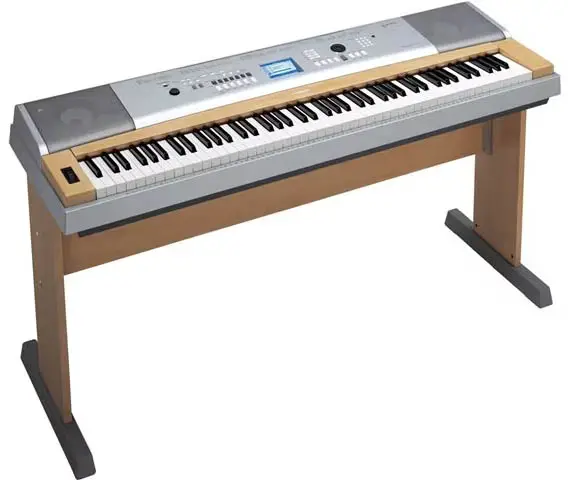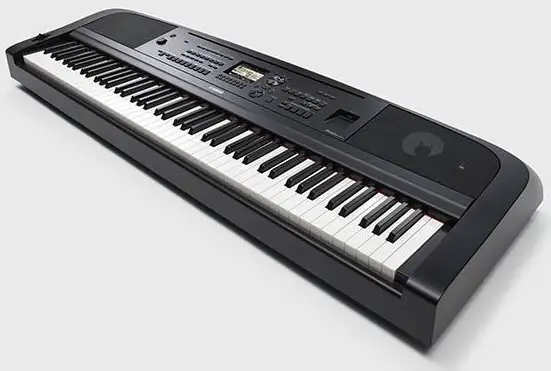In 2006 Yamaha launched its first DGX (digital grand) in the ‘600’ series. Previously, as early as 2002, Yamaha introduced the DGX line with the DGX-200, followed by other models including models in the DGX-300 and DGX-500 line. They also brought out YPG models which had similar specifications to an equivalent DGX model but were coloured in champagne gold instead of black, white or silver casing.
Overview






Intended to be a mid-range portable digital piano series, there are currently six models in the DGX-6** collection:
- DGX-620 (with an equivalent YPG-625) – launched 2006
- DGX-630 (with an equivalent YPG-635) – launched 2008
- DGX-640 – launched 2010
- DGX-650 – launched 2013
- DGX-660 – launched 2016
- DGX-670 – launched 2021 (Buy)
Clearly, sound technology including more realistic and convincing reproduction of an acoustic grand piano in the digital realm has come on a lot in recent years, and so we can immediately see an improvement in the sound generation technology from the DGX-620 of 2006 to the DGX-670 of 2021.
Main Features
Sound
Yamaha doesn’t mention the sound technology used for the 620, 630 and 640 models except to say that it uses “sampling” or “Live! Grand Piano Sound”. AWM (Advanced Wave Memory) and its related successors has been common on a lot of Yamaha digital pianos. The DGX-650 and DGX-660 use Yamaha’s Pure CF Sound Engine, while the latest DGX-670 uses a Yamaha CFX sample base and VRM sound modelling.
The DGX-620 has a meagre and rather inadequate 32 note polyphony. This rises through the series to the DGX-670 which has a maximum 256 polyphony. It’s worth noting that much of this can be used with the increased number of accompaniments, voices and effects available on later models, although the benefit is most definitely felt when playing the grand piano instrument.
The number of non-piano sounds also increases with model. It is up to the individual musician to decide whether these additional sounds are required. In any case, it is fair to say that the piano sounds will not have been compromised simply by having more onboard sounds.
Keys
All six instruments feature 88-keys with Yamaha’s popular Graded Hammer Standard (GHS) keyboard. This means a feel more akin to that of an acoustic grand piano, with lower register keys feeling heavier than higher ones.
Accompaniments
All the keyboards feature an accompaniment/rhythm section which can be triggered and used to play harmonising chords. This is something not found on higher end professional digital pianos, suggesting these instruments are aimed more at beginner to intermediate players or those for whom live performance in a band or solo artist situation is a requirement.
The accompaniments will not rival that of Yamaha’s arranger keyboards, but still provides a useful base for both performing, composition and musical inspiration.
The number and scope of accompaniments increases on newer models.
Effects
Effects can provide interesting sound altering and enhancing capabilities. All DGX-6 series instruments come with reverb, chorus, harmony and master EQ, while later models include DSP (digital signal processing), Intelligent Acoustic Control, Stereophonic Optimiser, and mic effects for those instruments which include a mic in jack.
Learning
While not a significant feature on these instruments, there are some basic educational functions on each DGX piano, including the Yamaha Education Suite on the 650 and 660.
Speakers
Built in speakers are useful for many home pianists, removing the need for separate amplification, although they do increase the weight and price of the instrument. All DGX models are fitted with decent speakers.
Display
Most of the range feature a monochrome backlit LCD screen which, although having fairly low resolution, can be used for displaying small amounts of musical notation or lyrics/chord data and the like.
Technologies
Here are a few of the technologies found on the latest DGX models.
Intelligent Acoustic Control (IAC)
Designed to automatically adjust and control sound quality according to overall instrument volume, as heard through the internal speakers. Found on the 650, 660 and 670.
Stereophonic Optimizer
For headphone users on the DGX-670, it recreates the spacious sensation heard when playing an acoustic piano, mitigating the feeling over over-closeness often experienced when using headphones.
Virtual Resonance Modelling (VRM)
The VRM (Virtual Resonance Modeling) technology reproduces the complicated interaction between both string and soundboard resonance, and make the sound more like that of a real acoustic piano. Since resonance instantaneously occurs depending on the action of the keys and pedal, you can expressively vary the sound by changing the timing of your pressing the keys, and the timing and depth of your pressing the pedal.
Piano Room
The Piano Room features provide even greater piano performance enjoyment. Piano Room lets you select the desired piano type as well as different room ambiences—enabling a complete, realistic piano experience, as if you were playing an actual piano.
Specifications
Here’s a table of specifications for the six models, providing a comparison of the main features and capabilities of each instrument.
|
|
DGX-620 |
DGX-630 |
DGX-640 |
DGX-650 |
DGX-660 |
DGX-670 |
|
Number of Keys |
88 |
88 |
88 |
88 |
88 |
88 |
|
Keyboard |
GHS |
GHS |
GHS |
GHS |
GHS |
GHS |
|
Sound Generator |
Sampling |
Sampling |
Live! Grand Piano Sound |
Pure CF Sound Engine |
Pure CF Sound Engine |
Yamaha CFX |
|
Polyphony |
32 |
64 |
64 |
128 |
192 |
256 |
|
Number of Voices |
127 panel voices + 12 drum/SFX kits + 361 XGlite voices |
130 panel voices + 12 drum/SFX kits + 361 XGlite voices |
142 panel voices + 12 drum/SFX kits + 381 XGlite voices |
147 + 15 Drum/SFX Kits + 381 XGlite, 1 Natural! Voice, 9 Live! Voices, 8 Sweet! Voices, 7 Cool! Voices |
151 + 15 Drum/SFX Kits + 388 XGlite, 1 Natural! Voice, 10 Live! Voices, 11 Sweet! Voices, 7 Cool! Voices |
601 Voices + 29 Drum/SFX Kits, 9 VRM Voices, 49 Super Articulation Voices, 23 MegaVoices, 11 Natural! Voices, 26 Sweet! Voices, 53 Cool! Voices, 68 Live! Voices |
|
Voice Features |
Dual, Split |
Dual, Split |
Dual, Split |
Dual, Split |
Dual, Split |
Dual, Split |
|
Effects: Reverb |
9 |
29 |
35 |
35 |
41 |
58 preset, 30 user |
|
Effects: Chorus |
4 |
24 |
44 |
44 |
44 |
106 preset, 30 user |
|
Effects: Harmony |
26 |
26 |
26 |
Y |
26 |
Y |
|
Effects: DSP |
– |
182 |
238 |
237 |
237 |
295 preset, 30 user |
|
Effects: Other |
Master EQ |
Master EQ |
Master EQ |
Master EQ, Intelligent Acoustic Control |
Master EQ, Intelligent Acoustic Control, Mic effects: Noise gate, compressor, 3 band EQ |
Master compressor, master EQ, part EQ, Intelligent Acoustic Control, Stereophonic Optimizer |
|
Pitch bend |
Y |
Y |
Y |
Y |
Y |
Y |
|
Accompaniments |
150 |
160 |
165 |
195 |
205 |
263 |
|
Songs |
30 preset, 5 user |
30 preset, 5 user |
30 preset, 5 user |
100 preset, 5 user |
100 preset, 5 user |
100 |
|
Recording |
5 track + style on 5 songs |
5 track + style on 5 songs |
5 track + style on 5 songs |
5 track + style on 5 songs |
5 track + style on 5 songs |
16 tracks, songs depend on capacity |
|
MIDI |
Y |
Y |
Y |
Y |
Y |
Y |
|
Display |
320×240 backlit LCD |
320×240 backlit LCD |
320×240 backlit LCD |
320×240 backlit LCD |
320×240 backlit LCD |
4.3″ 480×272 TFT Color WQVGA LCD |
|
Education |
Dictionary, Lession 1-3, Repeat & Learn |
Dictionary, Lession 1-3, Repeat & Learn |
Dictionary, Lession 1-3, Repeat & Learn |
Yamaha Education Suite: Waiting, Your tempo, Minus one, Repeat & Learn, Chord Dictionary |
Yamaha Education Suite: Waiting, Your tempo, Minus one, Repeat & Learn, Chord Dictionary |
Follow Lights, Any Key, Karao-Key, Your Tempo |
|
Memory |
8 banks x 2 types |
8 banks x 2 types |
8 banks x 4 types |
1.7MB |
1.7MB, 8 banks x 4 types |
20MB |
|
Connectivity |
Phones, DC IN 12V, USB to host, USB to device, Sustain |
Phones, DC IN 12V, USB to host, USB to device, Sustain |
Phones, DC IN 12V, USB to host, USB to device, Sustain, Pedal Unit |
Phones, DC IN 12V, USB to host, USB to device, Sustain, Pedal Unit, Aux IN |
Phones, DC IN 12V, USB to host, USB to device, Sustain, Pedal Unit, Aux IN |
Phones, DC IN 16V, USB to host, USB to device, Sustain, Pedal Unit, Aux IN, Mic IN |
|
Amplifier |
6W x2 |
6W x2 |
6W x2 |
6W x2 |
6W x2 |
6W x2 |
|
Speakers |
12cm x2 + 3cm x2 |
12cm x2 + 3cm x2 |
12cm x2 + 3cm x2 |
12cm x2 + 5cm x2 |
12cm x2 + 5cm x2 |
12cm x2 + 5cm x2 |
|
Power Consumption |
22W |
22W |
22W |
13W |
13W |
14.5W |
|
Dimensions |
1,398 x 457 x 153 mm (55-1/16″ x 18″ x 6″) |
1,398 x 457 x 153 mm (55-1/16″ x 18″ x 6″) |
1,397 x 445 x 146 mm (55″ x 17-1/2″ x 5-3/4″) |
1,397 x 445 x 146 mm (55” x 17-1/2” x 5-3/4”) |
1,397 x 445 x 146 mm (55” x 17-1/2” x 5-3/4”) |
1,397 mm × 445 mm × 151 mm (55″ × 17-1/2″ × 5-15/16″) |
|
Weight |
18.0kg (39 lbs. 11 oz.) |
18.0kg (39 lbs. 11 oz.) |
20.7kg (45 lbs. 10 oz.) |
22.5kg (49 lbs. 10 oz.) |
21kg (46 lbs. 5 oz.) |
21.4kg (47 lb, 3 oz) |
|
RRP* |
– |
– |
– |
$1,299 |
$1,299 |
$1,299 |
|
* RRP information was not available for all models. |
||||||
Yamaha’s latest two DGX models are categorised alongside their P Series of digital pianos, all considered to be more portable options than the likes of Clavinova or ARIUS digital pianos, and often have a wider feature base rather than focusing more exclusively on the piano itself.
Conclusion
The Yamaha DGX line of digital pianos appear to be a high quality yet reasonably affordable option for those who want a decent piano plus additional features. They may not match the feel or sound of Yamaha’s higher end digital pianos but for the price they offer a very good playing experience.
Currently, only the DGX-660 and DGX-670 are considered current, with all other models having been discontinued and therefore likely only available second hand. Bear in mind that the early models are a decade or more old and so may not be a wise purchase option unless an exceptional used model comes along.
Also worth comparing with similarly-priced offering from the likes of Casio and Roland.



